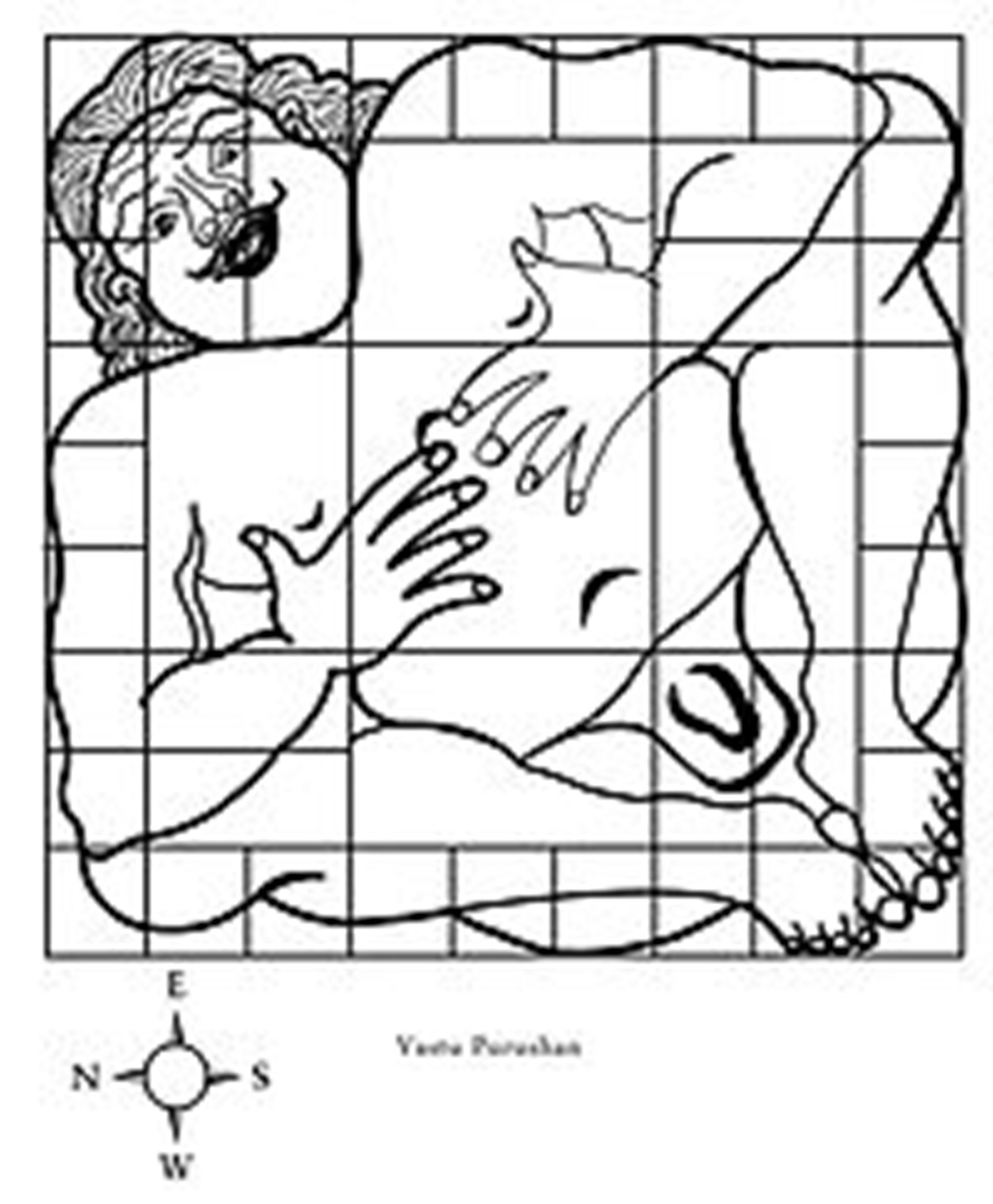VASTU SHASTRA

Vastu shastra also vastu veda and vastuvidya, "science of construction", is an ancient doctrine which consists of precepts born out of a traditional view on how the laws of nature affect human dwellings. The designs are based on directional alignments. It is primarily applied in Hindu architecture, especially for Hindu temples, although it covers other domains, including vehicles, vessels, furniture, sculpture, etc. The doctrine of Vastu Shastra is concerned primarily with architecture – building houses, forts, temples, apartments and other buildings.According to vastu shastra, the world comprises five basic elements known as the pancha maha bhoota. Out of the eight planets, ours has life because of the presence and balance of these five elements. The five elements are as follows.
EARTH (Bhumi) - Earth, the third planet in order from the sun, is a big magnet with North and South poles as centers of attractions. Its magnetic field and gravitational force has considerable effects on everything on the Earth, living and non-living. In astrology earthy signs are 2 .Venus, 6 Mercury, 10 Saturn.
WATER (Jala) - This is represented by rain, river, sea and is in the form of liquid, solid (ice) and gas (steam, cloud). It forms part of every plant and animal. Our blood is mostly water. In astrology watery signs are 4 moon, 8 Mars, 12 Jupiter.
AIR (Vayu) - As a life supporting element, air is a very powerful life source. Human physical comfort values are directly and sensitively dependent on correct humidity, air flow, temperature of air, air pressure, air composition and its content.In astrology airy signs are 3 Mercury, 7 Venus, 11 Saturn.
FIRE (Agni) - Represents light and heat which account for day, night, the seasons, energy, enthusiasm, passion and vigour. In astrology Fiery signs are 1 Mars , 5 Sun , 9 Jupiter.
SPACE (Akasha) - The akasha provides shelter to all the above elements. It is also considered the primary conductor of all energy sources within the universal context - physical energies such as sound and light, social energies such as psychological and emotional, and cognitive energies such as intellect and intuition.
In India, there are temples devoted to the Five elements called ‘Panchbhoota Sthalams’, each of which represents one of the ‘Elemets’. Every temple has ‘Lord Shiva’ worshipped in the form of ‘Shiva Lingam’ related with one of the basic five elements (‘Pancha Bhootas’).
The five temples of ‘Pancha Bhootas’ are:
- Chidambaram Natarajar temple representing ‘Akasha’ (Space),
- Thiruvanaikoil Jambukeswarar temple representing ‘Jalam’ (Water),
- Kancheepuram Ekambareswarar temple representing ‘Prithvi’ (Earth),
- Thiruvannamalai Arunachaleswarar temple representing ‘Agni’ (Fire), and
- Sri Kalahasthi Nathar temple representing ‘Vayu’ (Air).
There is an invisible and constant relation between all the five elements. Thus, the person can improve their conditions by properly designing their buildings by understanding the effectiveness of these five natural forces. Vaastu shastra combines all the five elements of nature and balances them with the person and the material. It takes advantage of the benefits bestowed by the five elements of nature to create a congenial living and working environment thereby facilitating spiritual well-being and paving the way for enhanced health, wealth, prosperity and happiness.
In Indian architecture, the dwelling is itself a shrine. A home is called manushyalaya, literally, "human temple". It is not merely a shelter for human beings in which to rest and eat. The concept behind house design is the same as for temple design, so sacred and spiritual are the two spaces. The "open courtyard" system of house design was the national pattern in India before Western models were introduced. The order introduced into the "built space" accounts for the creation of spiritual ambiance required for the indweller to enjoy spiritual well-being and material welfare and prosperity. At right is a typical layout of a square building, with a grid of 9x9=81 squares, meant for family persons (for scientists, artists and yogi a grid of 8x8=64 is prescribed). The space occupied by the central 3x3=9 squares is called Brahmasthanam, meaning the "nuclear energy field". It should be kept unbuilt and open to the sky so as to have contact with the outer space (akasha). This central courtyard is likened to the lungs of the human body. It is not for living purposes. Religious and cultural events can be held here—such as yajna (fire rituals), music and dance performances and marriage. The row of squares surrounding the Brahmasthanam is the walkway. The corner spaces, occupying 2x2=4 squares, are rooms with specific purposes. The northeast quarter is called Isanya, the southeast Agni, the southwest Niruthi and northwest Vayu. These are said to possess the qualities of four respective devatas or gods—Isa, Agni, Niruthi and Vayu. Accordingly—with due respect to ecological friendliness with the subtle forces of the spirit—those spaces (quarters) are assigned as follows: northeast for the home shrine, southeast for the kitchen, southwest for the master bedroom and northwest for the storage of grains. The spaces lying between the corner zones, measuring 4x6=24 squares (6 on each side), are those of the north, east, south and west. They are meant for multi purposes.
Vastu Purusha Mandala

The concept of Vastu Purusha
The Vastu Purusha Mandala is an indispensable part of vastu shastra and constitutes the mathematical and diagrammatic basis for generating design. It is the metaphysical plan of a building that incorporates the course of the heavenly bodies and supernatural forces. Purusha refers to energy, power, soul or cosmic man. Mandala is the generic name for any plan or chart which symbolically represents the cosmos.
In Hindu cosmology the surface of the earth is represented as a square, the most fundamental of all Hindu forms. The earth is represented as four-cornered in reference to the horizon's relationship with sunrise and sunset, the North and South direction. It is called Chaturbhuji (four cornered) and represented in the form of the Prithvi Mandala. The astrological charts or horoscopes also represent in a square plan the positions of the sun, moon, planets and zodiac constellations with reference to a specific person's place and time of birth.
The legend of the Vastu Purusha is related thus. Once a formless being blocked the heaven from the earth and Brahma with many other gods trapped him to the ground. This incident is depicted graphically in the Vastu Purusha Mandala with portions allocated hierarchically to each deity based on their contributions and positions. Brahma occupied the central portion - the Brahmasthana- and other gods were distributed around in a concentric pattern. There are 45 gods in all including 32 outer deities.
- North- Kubera- Ruled by lord of wealth (Finance)
- South- Yama- Ruled by lord of death - Yama (Damaging)
- East- Indra- Ruled by the solar deity- Aditya (Seeing the world)
- West- Varuna- Ruled by lord of water (Physical)
- Northeast {Eshanya} - Ruled by Shiva
- Southeast- Agni- Ruled by the fire deity - Agni (Energy Generating)
- Northwest- Vayu- ruled by the god of winds (Advertisement)
- Southwest- Pitru/Nairutya, Niruthi- Ruled by ancestors (History)
- Center- Brahma- Ruled by the creator of the universe (Desire)
The Vastu Purusha is the presiding deity of any site. Usually he is depicted as lying on it with the head in the northeast and legs in the southwest but he keeps changing position throughout the year.
Vastu shastra prescribes desirable characteristics for sites and buildings based on flow of energy called Vaastu Purusha. The morning sun is considered especially beneficial and purifying however the sun does not play a specific role in the Vaastu shastras. In fact it is not mentioned in the texts. None of the heavenly bodies are mentioned in the Vaastu Shastras hence they are not considered in the proper application of Vaastu principles.
Energy is primarily considered as emanating from the center of the building. Many people believe that it comes from the North East corner but in fact it comes from the Brahmasthan or center of the building. It originates from subtle earth energy called Vaastu Purusha and subtle cosmic energy (Unified Field) called Vastu Purusha which meet in the center of the building and then spread outward in all directions. these two energies unite and form the five elements which then distribute in the for corner zones. (see Fabric of The Universe: The Origins, Implications, and Applications of Vastu Science and Vaastu Technology).
While many people think that "Vaastu energy" is emanating from the North East, that is a misunderstanding. People also attempt to equate the energy of the house with the planets. That is another misconception. Vaastu energy emanates from the central part of the house (Brahmasthan) and not from the east. (Pranava Veda and Vaastu Shastras). This energy is a mixture of Vaastu energy, which is subtle energy from the earth, and Vastu energy which is subtle energy from Consciousness itself. Many assumptions are made about Vaastu Science that are completely untrue. From these assumptions people have made up ways to "correct vaastu" by selling Yantras, Crystals etc. for that purpose. This is completely innapropriate as there is nowhere in the Vaastu Shastras that indicates that any of these devices can correct faulty Vaastu. Once a person becomes educated in Vaastu Shastra by an authentic Shilpi Guru (teacher of Vaastu shastras) then it becomes clear that these ideas are erroneous.
The effect of vastu is permanent, because the earth has been revolving around the sun, in geo stationary orbit for over 400 crores years creating the magnetic effect caused by rotation.
Fees : Clients shall have to write the full details of the required vastu services and details of his premises i.e House, Plot , Factory, Farm house, Building, Shop etc. Then He or She shall be replied to/intimidated about the fee structure for the intended services. Rate will vary for only Seeing the map, Site visit, Full layout of the plot, Telephonic discussion, etc. After receiving the quotation the client has to deposit full money in our account through our internet payment facilities. After that the appointment will be fixed with Acharya Ji within 7 days or according to the time suitable to both the parties.



